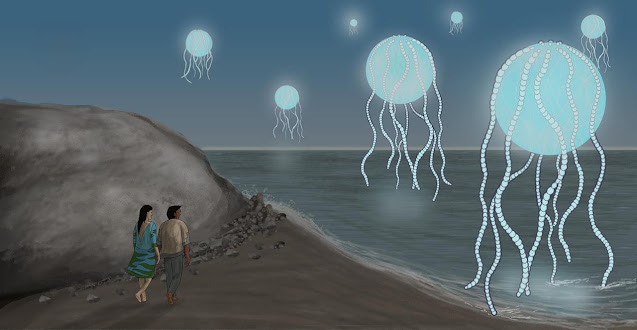From Atoms to Animals (Part 4) - Cells
We are getting closer to the rich diversity of life as we know it, but we are not quite there yet. With the exception of viruses, all living things on Earth are composed of cells. A cell is a highly complicated unit composed of a membrane (wall) containing fluid (cytoplasm), smaller functional substructures (organelles) and DNA.
Some lifeforms can be made of just one cell (unicellular); for example, bacteria. Organisms composed of many cells are multicellular. A human body is composed of around 37 trillion cells. So how did we get from self-replicating RNA and DNA to these conveniently put-together miniature contraptions?
The membrane, or wall of the cell is a vital component. This is made mostly of a layer of lipid molecules called phospholipids. This molecule is special because it composed of a “head” that is chemically hydrophilic (attracted to water) and a “tail” that is hydrophobic (repelled by water).
In the presence of water these molecules will orient themselves in a regular formation, similar to how a magnet causes small metal objects (such as iron filings or the needle of a compass) to point in a specific direction. A large number of phospholipid molecules packed closely together will form a sheet or layer separating a high concentration of water on one side from a lower concentration of water on the other side. If this layer, or membrane, forms into an enclosing three-dimensional shape, in biology this structure is called a vesicle. The cell wall is one type of vesicle and similar structures within the cell – such as the nucleus, which contains DNA – is another example.
As vesicles form naturally from just the chemical properties of the lipid molecule, it is easy to imagine how such a structure could form the basis of the first ‘protocell’, a protective membrane for DNA and other components of the cell.
This then raises the question, however: What about those organelles? How did they come into existence? The most popular hypothesis to explain this is symbiogenesis.
Symbiosis is a long-term biological interaction between two different species. For example, a lichen is a composite organism consisting of an algae or cyanobacteria living among the filaments of a fungus. It is a “mutually beneficial relationship”: the fungus benefits from the carbohydrates produced by the algae (which uses photosynthesis) and the algae benefits from the fungal filaments which protect it from the environment and retain moisture.
There are many other examples of symbiotic relationships in nature. When one organism is contained within the body of the other, this is called endosymbiosis. For example the pea aphid contains a bacteria that produces amino acids which the insect itself needs but cannot make for itself. In return, the aphid acts as a host for the bacteria, which cannot live independently.
Symbiogenesis is the theory that eukaryotic cells (containing a nucleus) evolved from single-celled prokaryotic organisms (without a nucleus). For example, in animal cells the mitochondria is the organelle that produces most of the chemical energy for the cell. Each mitochondrion has a membrane and contains its own DNA. It closely resembles a bacterium (specifically Rickettsia rickettsii). The chloroplast organelles in a plant cell, which perform photosynthesis, also contain DNA and are very similar to photosynthetic cyanobacteria. The theory here is that single-celled organisms established very close symbiotic relationships which developed into more complex forms over billions of years.
The oldest fossils we have found are those of bacteria from 3.5 billion years ago. However, the first unicellular life may have existed on Earth even earlier, up to 4.5 billion years ago (only 500 million years after the formation of the planet).
Analysis of DNA from a wide range of species shows that all life that we know has a last universal common ancestor (LUCA), probably a bacteria-like organism that lived four billion years ago near hydrothermal vents. LUCA forms the root of the phylogenetic ‘tree of life’, a diagram that shows how all known organisms are related.


Comments
Post a Comment